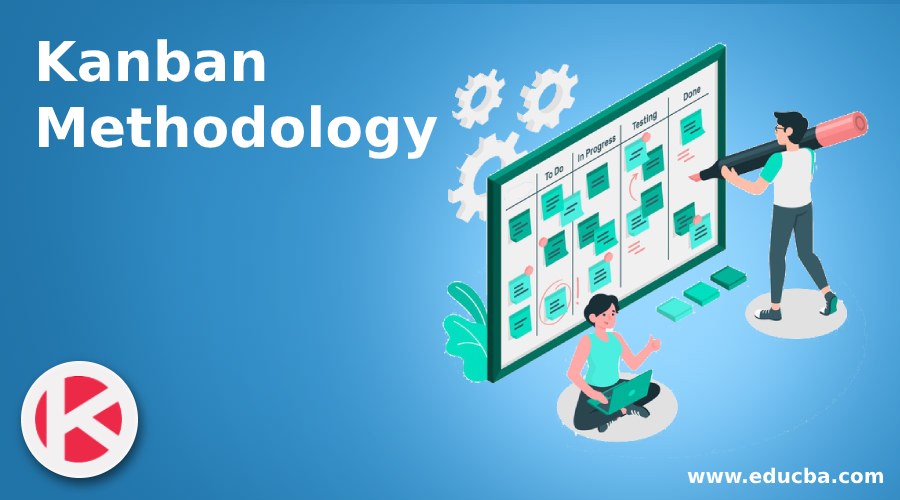Updated May 30, 2023

Introduction to Kanban Methodology
Kanban Methodology is an incremental but not iterative agile project management framework that deals with frequently delivering, visualizing workflow, tightly collaboration, continuous learning, process improvement, controls the work in progress, just-in-time development, and larger development cycle for a software product. It is not a software development methodology but an approach or set of ideas to manage and improve workflow and teams/organizations to visualize their work in software development.
Explanation of Kanban Methodology
In Kanban Methodology, it continuously improves the process and the way to manage the flow of work rather than managing team members and their work. The team behaves as self-organized as a whole. The team can handle work, focusing on getting the customer higher product quality and good value.
In this Kanban Methodology, the total task or work is visualized using cards on a Kanban Board, i.e., a pictorial representation of your work. That board is visible for the whole team to check how much work is pending, how much is in progress mode, how much work is complete, or who is focusing on it, i.e., it shows the status of the whole team and project. The Kanban board is updated daily depending upon the status of work progress by the team. It consists of multicolored cards showing a specific task.
The Kanban Methodology depends on various principles, such as:
- Visualize Work
- Limit Work in Progress
- Pulling New Work
- Measure and Learn
- Manage the Workflow
- Process improvement
- Working Together
- Deliver new Ideas
- Just in-Time Development
- Welcome to Incremental Change
1. Visualize Work
It is the basic principle of the Kanban Methodology. Here Kanban Board is used for the pictorial representation of work. It provides the status of the workflow of the teams and projects. The product owner can add the task as a user story in the Kanban board, and the team will update the status of the visualized workflow.
2. Limit Work in Progress
In this process, we can’t use multiple tasks or user stories at a time in progress mode, so the whole team’s work on a user story should be complete before choosing another one. It enhances product quality, smoothing workflow, and deliver frequently.
3. Pulling New Work
As the Kanban method is a transparent process, so all the task or user story is placed in one place is called Backlog. After completing one user story, we choose or pull a new task from the Backlog. We choose a new task once it is in completed or done status.
4. Implement Feedback Process
This methodology always welcomes feedback which is used to provide a highly expected quality product development. It always reviews feedback in each stage of the workflow in Kanban Board. It is imposed early in the workflow to eliminate impediments from each workflow stage.
5. Manage the Workflow
This methodology uses the Kanban board to manage the total workflow. Here a whole team is involved in the task analysis, so it improves the work flow, and the task will be completed before the scheduled time. It provides the actual status of the application.
6. Process Improvement
The team will work together in this methodology to improve the process and product level. It emphasizes small changes and accepts them gradually to improve the process. Also, it directs us to learn and apply the different technology in application to produce the best quality product.
7. Working Together
In this methodology, the business people and developers must work together daily throughout the projects. The best architects, requirements, designers, and developers emerge from the self-organized teams.
8. Deliver With New Ideas
The main idea behind the Kanban approach is to improve the team quality and process as it supports the new ideas from the teams in each phase of the workflow.
9. Just In Time Development
The development of applications based on customer demand, i.e., the approach of a pull system, not a push. In this methodology, we develop an application not to push to a client directly. It indicates what to develop, how, and when to develop. It provides good quality with new feature products.
10. Welcome to Incremental Change
This methodology enables incremental changes at any workflow stage with continuous product delivery. It welcomes changing requirements, even late in development.
Advantages of Kanban Methodology
- It increases the Productivity of the team.
- It provides flexibility and sustainable development.
- It deals with continuous process improvement and delivery.
- Kanban methodology eradicates the bugs from the process.
- Increase the efficiency of delivering a high-quality product.
- It depends on just-in-time development.
- It limits the work in progress, so it enhances the output.
- It focuses on one task at a time.
- It provides the project status in Kanban Board; it’s open to all.
- It improves the workflow and limits the time cycle.
- It maintains workflow status, collaboration with the team, and sustainable development.
Conclusion
This article describes the Kanban Methodology in the Agile software development life cycle process. Like the scrum process, it helps to team members work together. There are working teams as a whole without prescribed roles. The main goal is to visualize the work and workflow, improve team process & quality, and track of deployment status of the product.
Recommended Articles
This is a guide to Kanban Methodology. Here we discuss the introduction to Kanban Methodology, its explanation, principles, and advantages. You can also go through our other related articles to learn more –


